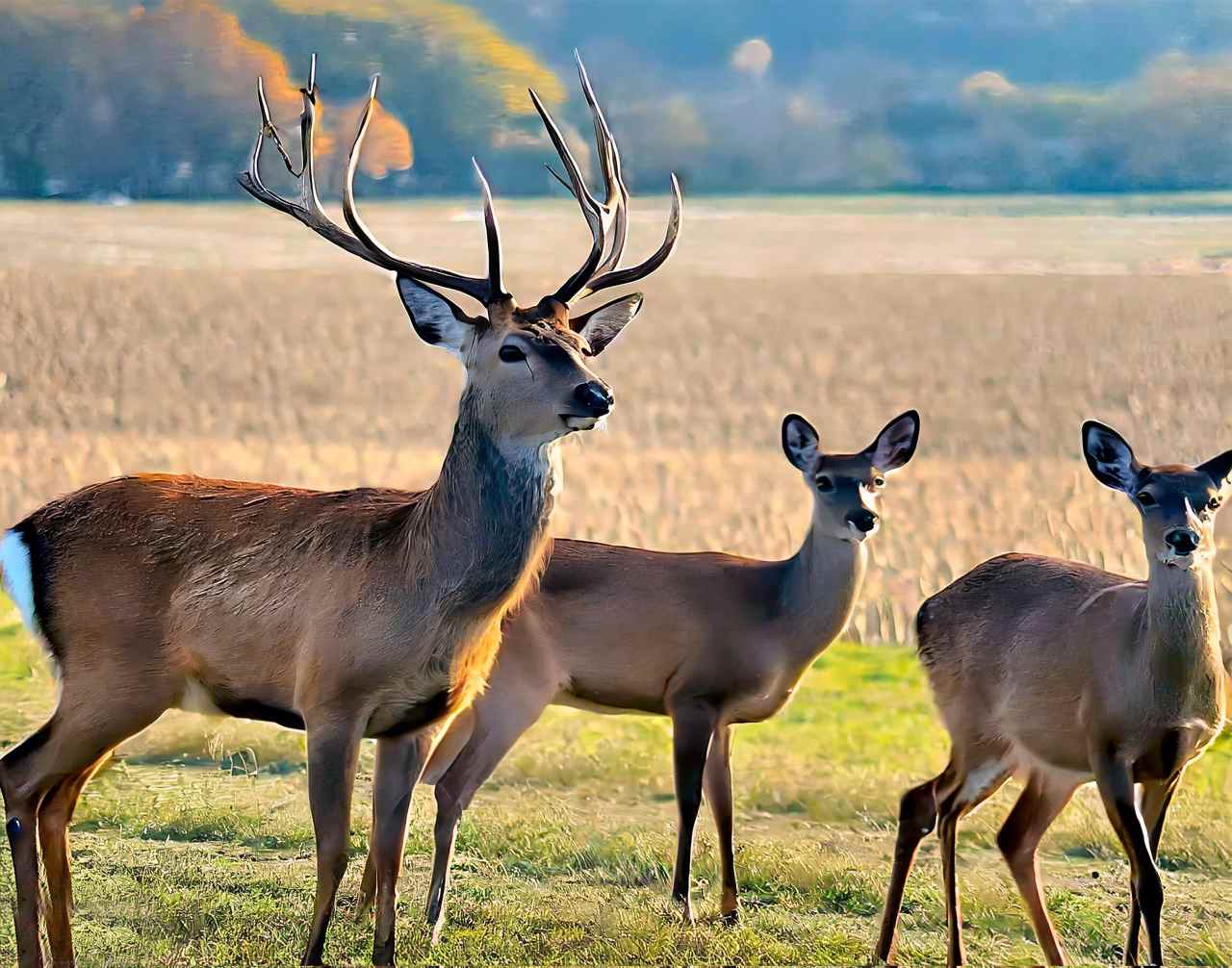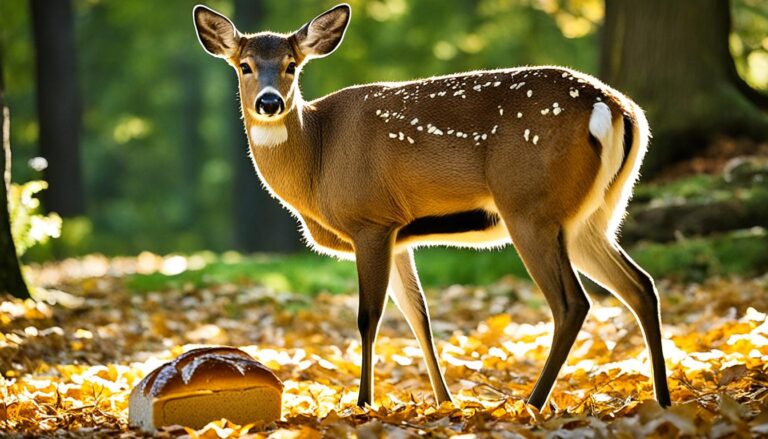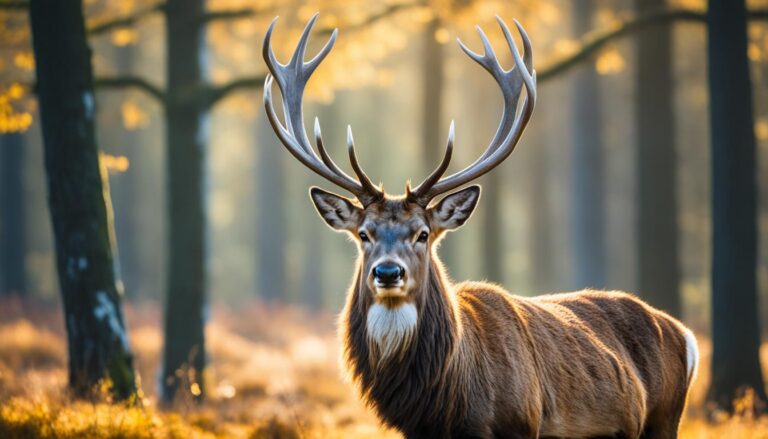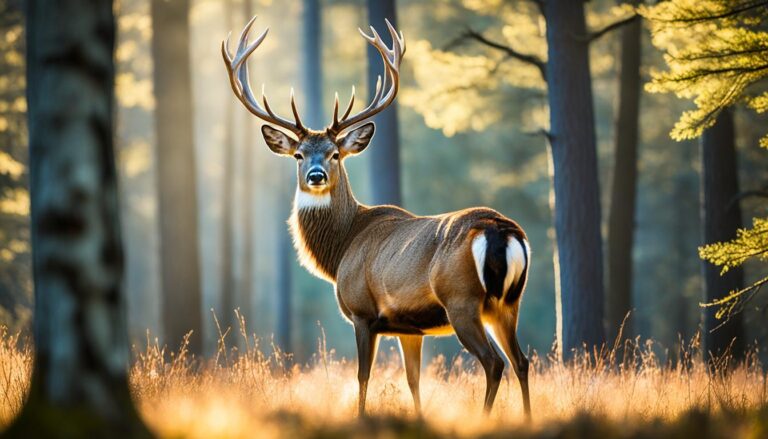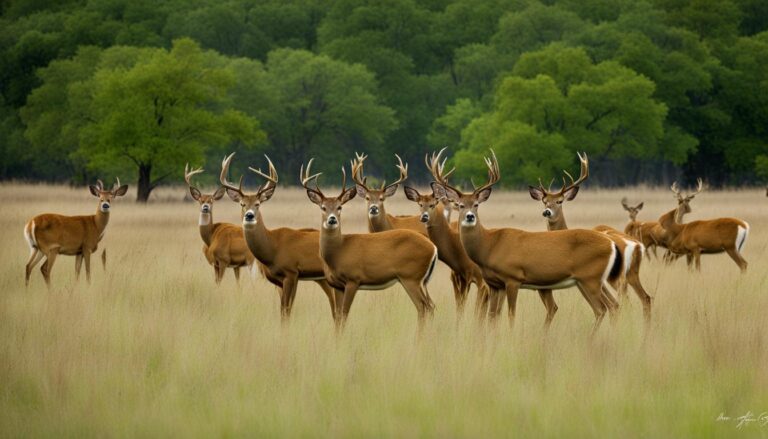What Is The Difference Between A Roe Deer And A Fallow Deer?
Have you ever wondered, what is the difference between a roe deer and a fallow deer? Roe deer and fallow deer, two distinct members of the deer family, share the lush forests and wide-open meadows of Europe and many other areas across the globe. Although these two species may seem to be quite similar at first sight, there are some significant anatomical and behavioral distinctions between them. In this article, we’ll compare roe deer and fallow deer closely and emphasize the key characteristics that set them unique.
Roe deer Vs Fallow deer
Roe deer (Capreolus capreolus) and fallow deer (Dama dama) vary in size, appearance, behavior, habitat, and distribution. Roe deer, which live alone in woods and woodlands, are small and slender with three-pointed antlers. Fallow deer are bigger with palmated antlers, live in gregarious herds in grasslands and meadows, and are found in Europe, North America, Australia, and other countries. The two deer species are simple to distinguish because to their differences.
| Characteristic | Roe Deer (Capreolus capreolus) | Fallow Deer (Dama dama) |
|---|---|---|
| Rump and Tail | White/cream rump with no visible tail | White heart-shaped rump with black border and tail |
| Coat Color | Red/brown in summer, grey/brown in winter | Variable coat colors, often brown with white spots |
| Nose and Chin | Distinctive black nose and white chin | Lack the black nose and white chin |
| Antlers | Small, branched antlers with up to 3 points | Large, palmate (broad and flattened) antlers |
| Size | Average height at shoulder 60-75cm | Larger, exceeding 100cm at the shoulder |
| Behavior | Solitary or in small groups, territorial males during the rut | Larger groups, different mating behaviors, and herds |
| Diet | Selective browsing, eating leaves, tree shoots, herbs, brambles, and more | Generalist herbivores, consuming grasses, leaves, and agricultural plants |
| Habitat | Woodlands, mixed woodlands, heathlands, and more | Versatile habitats including woodlands, grasslands, and urban areas |
| Tail Shape | Small tail, not readily visible | Larger tail that hangs over the rump patch |
| Taxonomy | Genus Capreolus, Family Cervidae | Genus Dama, Family Cervidae |
Size and Weight
The size difference between roe deer and fallow deer is one of the most obvious. Compared to fallow deer, roe deer are substantially smaller and have more slender, compact bodies.
- The typical height of a roe deer is between 60 and 75 cm at the shoulder. Males weigh between 10 and 25 kg, whilst females weigh 10 to 16 kg.
- Fallow deer are much bigger than other types of deer, with males growing as tall as 90 cm at the shoulder and females as tall as 80 cm. On average, male fallow deer weigh 55–95 kg, while females weigh 35–56 kg.
| Characteristic | Roe Deer (Capreolus capreolus) | Fallow Deer (Dama dama) |
|---|---|---|
| Average Height (at shoulder) | 60-75 cm | Males: Up to 90 cm, Females: Up to 80 cm |
| Average Weight | Males: 10-25 kg, Females: 10-16 kg | Males: 55-95 kg, Females: 35-56 kg |
So if you see a deer that seems rather little and delicate, it probably belongs to the roe deer species. Fallow deer are often larger and more muscularly built.
The color and markings
| Characteristic | Roe Deer | Fallow Deer |
|---|---|---|
| Summer Coat Color | Reddish-brown | Varies from chestnut brown to almost white |
| Winter Coat Color | Grayish-brown | Brown or gray |
| Unique Markings | White chin, white rump patch with oval shape in males and heart shape in females | White spots, black stripe down tail, black horseshoe around rump |
| Coat Pattern in Fawns | Dappled in summer | Fawns have spots |
Roe deer and fallow deer coats also have very different colors and patterns. This may make it easier to visually tell them apart.
Roe Deer
- Roe deer have a reddish-brown coat in the summer.
- Their fur becomes more grayish-brown in the winter.
- They have a distinguishing white chin and neck in addition to a black nose.
- The huge white rump patch is their most distinguishing feature. On men, it has an oval form; on women, it has a heart shape.
- Roe deer’s rump patch hairs flare up when they are scared, making them considerably more noticeable. This serves to alert other roe deer to any possible threat.
Fallow Deer
- Compared to roe deer, fallow deer have significantly greater diversity in their coat color. They vary in color from chestnut brown to virtually white to black.
- In the summer, their fur develops recognizable white spots. In the winter, they turn to a simple brown or gray.
- They have a black stripe down their tails and a black horseshoe form around their rumps. As a result, a pattern of black and white is produced.
- Unlike the adults, fallow deer fawns are the only ones that have spots.
So, if you see a fallow deer, it will likely have a speckled rump or a three-toned pattern of white, black, and brown. The intricate markings of roe deer are absent.
Antlers
The antlers of male deer may make differentiating between species simple. Antler forms and branching patterns are quite different between roe and fallow deer.
Roe Deer Antlers
Antlers on roe deer may only have three points at most, making them rather tiny.
- They are oriented vertically, with little spreading out to the sides.
- The antlers contain numerous knobby protrusions and a rough, gnarled feel.
- Their largest size is just approximately 30 cm.
Fallow Deer Antlers
- Compared to roe deer, fallow deer antlers are much bigger and more stunning.
- They are palmate, or flattened and widely spread out like open hands.
- The antlers have various branching patterns with anything between 8 and 30 points.
- Compared to roe deer antlers, they are smoother.
- The antlers of fallow deer may grow to be over 90 cm long!
| Characteristic | Roe Deer | Fallow Deer |
|---|---|---|
| Antler Size | Up to 30 cm | Over 90 cm |
| Antler Shape | Short and spiky | Flattened and branching |
| Points (Typical) | Up to 3 | 8 to 30+ |
So if you see a buck roe deer, it will have short, spiky antlers. A fallow deer stag is identified by large, flattened, branching antlers.
Behavioral Differences
| Characteristic | Roe Deer | Fallow Deer |
|---|---|---|
| Social Structure | Solitary or in mother-offspring pairs, rarely small groups | Form large herds, males create bachelor groups |
| Activity Patterns | Most active at dusk and dawn, can be active at night | More active throughout the day, moving early morning and late afternoon into the evening |
| Territoriality | Males are territorial from March to August during mating season | Males use a lekking system to congregate in small territories |
| Breeding Season | Mid-July to late August, with delayed implantation in females | Mating in October, fawns born in June |
When it comes to social structure, activity, territoriality, and reproduction, roe deer and fallow deer exhibit relatively different behavioral characteristics. These habits might provide hints about the kind of deer.
Social Structure
- Roe deer are mostly solitary creatures that live alone or in mother-and-calf couples.
- In order to forage, they could form tiny, loose groups in the winter. Large herds, however, are uncommon.
- Fallow deer, on the other hand, are quite sociable. They often gather in large herds of fifty or more animals.
- For a large portion of the year, fallow deer create bachelor groups of males apart from female groups.
So, whether you see a single deer or a couple of deer, it’s probably a roe deer. A large herd might be fallow deer.
Activity Patterns
- Roe deer move less throughout the day and are most active at twilight and morning. They are also capable of becoming active at night.
- Fallow deer are more active throughout the day, moving about in the early morning and late afternoon into the evening.
- Fallow deer stags spend their time mating during the rut, which causes them to become nearly entirely nocturnal.
So, roe deer benefit from crepuscular activity whereas fallow deer benefit from diurnal activity. Movement at night is probably a fallow deer.
Territoriality
- Roe deer males are territorial from March through August when mating season is in full swing. They tenaciously repel competitors from entering their realm.
- Fallow deer stags don’t have separate home range areas; instead, they use a lekking system in which they congregate in tiny territory to attract females.
Reproduction
- From the middle of July until the end of August, roe deer breed. Early in January, delayed implantation occurs for females.
- Fallow deer mate in October, and after a typical gestation period, fawns are born in June.
Fawns in the summer are a sign of roe deer, whereas rutting activity in the fall and winter is a sign of fallow deer.
Preferences for habitat
| Characteristic | Roe Deer | Fallow Deer |
|---|---|---|
| Preferred Habitats | Mixed woods, moorlands, farms, open fields, forest edges | Mixture of broadleaf, coniferous, and open meadows along forests |
| UK Distribution | Widespread throughout England, Scotland, and Wales, except northern Scotland | Southern England dominates, although population growing. |
| Preferred Locations | Small forests, woodland margins | Open meadows and dense woodlands |
Roe deer and fallow deer have different preferred habitats, which might help with identification if you are aware of the setting in which you are seeing them.
- Roe deer flourish in mixed woods that are surrounded by moorlands, farms, open fields, and forests. They like woodland margins in particular.
- Broadleaf, coniferous, and mixed woods are preferred by fallow deer because they are more heavily forested. They also visit the open meadows close to the woods.
Therefore, a deer in a dense forest is more likely to be a fallow, but a deer on a small forest or woodland edge may be a roe deer.
Geographic distribution
Roe deer and fallow deer’s geographic distribution in Great Britain may be estimated from their natural habitats.
- Except for the northern regions of Scotland, roe deer may be found all throughout England, Wales, and Scotland. They are originally from the UK.
- Fallow deer were brought to southern England from continental Europe and are mostly found there. Despite population expansion, their range remains constrained.
Roe deer thus have a larger range across Britain, but fallow deer are presently more concentrated in England’s central and southern counties. There is no doubt that a deer seen in the far north is a roe.
Droppings and Tracks
Even after a deer has left the region, its identification may be verified by carefully examining its traces and droppings.
- Tracks left by roe deer are around 4.5 cm long and 3 cm broad. The traces of fallow deer are bigger.
- Although the droppings are similar, fallow deer scat is often bigger and more oval-shaped.
- To be certain, search for further indicators like tracks. Roe deer and sheep droppings might be mistaken.
Even inexperienced nature lovers may dependably distinguish between roe deer and fallow deer with careful observation and knowledge of the fundamental distinctions. The next time you see a deer, identify the species by examining its markings, size, antlers, habitat, and activity patterns. Let the hints tell you whether you saw the graceful and herd-loving fallow deer or the tiny and lonesome roe deer.
Frequently Asked Questions
What is the size difference between a roe deer and a fallow deer?
A fallow deer (Dama dama) and a roe deer (Capreolus capreolus) are significantly different in size. Fallow deer are substantially bigger than roe deer, with shoulder heights sometimes surpassing 100 cm (39.4 inches). Roe deer are smaller, with an average shoulder height ranging from 60 to 75 cm (23.6 to 29.5 inches). One of the most important characteristics that distinguishes different deer species is the difference in size.
What is the difference in coat color between a roe deer and a fallow deer?
Both roe deer and fallow deer have notable variances in their coat colors. In the summer, roe deer have a reddish-brown coat that goes gray in the winter. They keep their hue quite constant throughout the year. The coats of fallow deer, on the other hand, may vary greatly in color, from deep brown to light brown to virtually white, and they can change with the seasons.
How do the antlers of roe deer and fallow deer differ?
Roe deer antlers are short (up to 30 cm long), gnarled, and may have up to 3 points. The antlers of fallow deer are substantially longer (about 90 cm long), palmate, and have a wide range of branching, from 8 to more than 30 points, with a smooth texture.
What do roe deer like to eat?
Roe deer are herbivorous animals with a wide-ranging and picky diet. Along with tree shoots, herbs, brambles, ivy, and different woody plants, they typically eat grass, leaves, new shoots, and berries. Fresh shoots, leaves, and stems that provide more energy than grazing on grass alone are the kind of food they like to consume, which is how they choose to fuel themselves. Due to their relatively short digestive tracts, roe deer must get all of their daily energy from plants that are rich in soluble carbohydrates. They consume a broad variety of plant species, such as ferns, conifers, deciduous trees, shrubs, crops, grasses, moss, fungi, and lichens. They spread out over their habitat in the summer, but they concentrate on certain feeding locations in the winter. In conclusion, roe deer have a diverse and picky diet, eating things like leaves, grass, berries, buds, and even bark.
Do roe deer and fallow deer behave differently in terms of social groups?
Yes, fallow deer are far more sociable and form vast herds of 50+ animals, while roe deer prefer to be solitary or in mother-offspring pairs. All-male bachelor groups of fallow deer are also formed.
Are roe deer and fallow deer found in the same habitats?
Roe deer and fallow deer may both be found in forest settings, although they usually occupy somewhat distinct niches. Open mixed forests, coniferous or deciduous woodlands, and heathlands are the habitats where roe deer are most often seen. On the other hand, fallow deer have a wider range of habitats and may survive in a variety of settings, including urban settings, grasslands, and even woods.
When are the breeding seasons for roe deer vs. fallow deer?
In the summer, from mid-July until late August, roe deer breed. Fawns are born in June after the fallow deer breed in October.
What is the difference in tail shape between a roe deer and a fallow deer?
Another distinction between roe deer and fallow deer is the form of the tail. Fallow deer have bigger tails that dangle over their unique rump patch, which is often creamy yellow, whereas roe deer generally have smaller tails that may not be easily noticeable.
Are roe deer and fallow deer closely related species?
Fallow deer (Dama dama) and roe deer (Capreolus capreolus) are not closely related species. They are members of many genera within the Cervidae family. Fallow deer belong to the Dama genus, whereas roe deer are a member of the Capreolus genus. They are distinguished from one another taxonomically by these variations in genus and other distinctive traits.
Conclusion
In many parts of the United Kingdom, roe deer and fallow deer share the status as common deer species. However, despite some outward similarities, they are extremely different species with substantial variances in their anatomy, behavior, preferred habitats, and other characteristics.
Important identifying guidelines to distinguish roe and fallow deer include:
- Size: Roe deer are much smaller
- Coloration: Fallow have spots and intricate black-and-white patterns, while roe are reddish with white rump patches.
- Antlers: a fallow stag will have big, flattened antlers that branch out, while a roe buck will have short, spiky antlers.
- Roe deer have solitary social behaviors, while fallow deer create vast herds.
- Habitat: Fallow prefer deep forests, whereas roe prefer forest margins and mosaics.
- Range: Fallow deer are mainly confined to England, whereas roe deer have a greater range throughout the UK.
Most outdoor lovers ought to be able to clearly tell a roe deer from a fallow deer with adequate observation possibilities. Additionally, even in the absence of direct observations, a species’ presence may be determined through signs like as tracks, droppings, behavior, and habitat. Any wildlife observation experience in the woods and fields of Britain is improved by knowing the different types of deer.
- Wyoming Deer Season 2025-2026 New Schedule & Rules - 15 September 2025
- Wisconsin Deer Season 2025-2026: WI Deer Hunting Guide [Schedule, Rules, Licenses] - 15 September 2025
- West Virginia Deer Season 2025-2026 Complete Date & Guide - 15 September 2025
